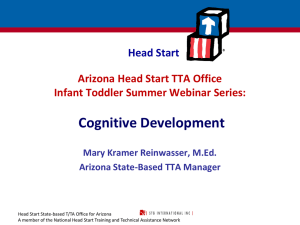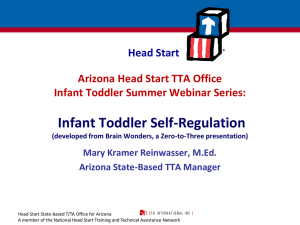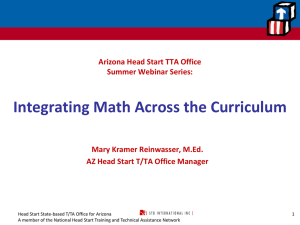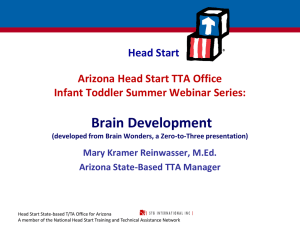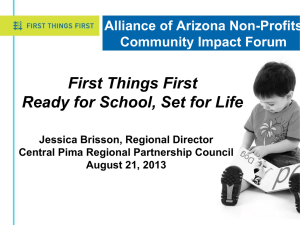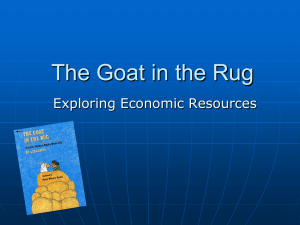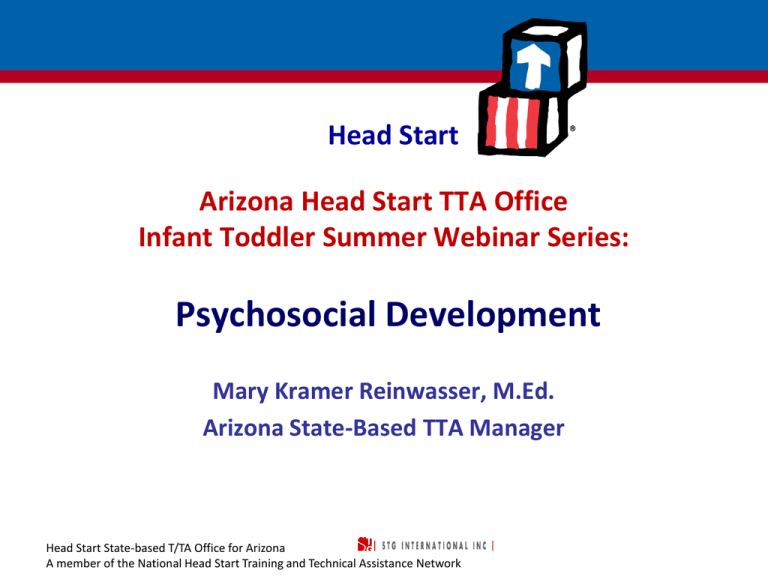
Head Start
Arizona Head Start TTA Office
Infant Toddler Summer Webinar Series:
Psychosocial Development
Mary Kramer Reinwasser, M.Ed.
Arizona State-Based TTA Manager
Head Start State-based T/TA Office for Arizona
A member of the National Head Start Training and Technical Assistance Network
Agenda
Part One
• Theories of development
• Psychosocial development
• Self-regulation
• Temperament
Part Two
• Attachment
• Social referencing
Head Start State-based T/TA Office for Arizona
A member of the National Head Start Training and Technical Assistance Network
2
Learning Outcomes
Part One
• Participants will be able to describe several theories of
development
• Participants will be able to define psychosocial development
• Participants will be able to explain why self-regulation is
important in development
• Participants will be able to name three temperament styles
Part Two
• Participants will be able to describe attachment types
• Participants will be able to define social referencing
Head Start State-based T/TA Office for Arizona
A member of the National Head Start Training and Technical Assistance Network
3
Theories of Development
Head Start State-based T/TA Office for Arizona
A member of the National Head Start Training and Technical Assistance Network
4
Theories of Development
Freud/Psychosexual
Piaget/Constructivism
Vygotsky/Sociocultural
Head Start State-based T/TA Office for Arizona
A member of the National Head Start Training and Technical Assistance Network
Skinner/Behaviorism
Erikson/Psychosocial
5
Psychosocial Development Theory
• Psychosocial development theory is based on eight stages of
development
• Erikson’s theory is based on the idea that development
through life is a series of stages which are each defined by a
crisis or challenge
• The early stages provide the foundations for later stages so
Erikson says that if a child does not resolve a crisis in a
particular stage, they will have problems in later stages
Head Start State-based T/TA Office for Arizona
A member of the National Head Start Training and Technical Assistance Network
Erikson and Freud Comparison
Approximate Ages
Birth to 1 year
Freud's Stages of
Psychosexual Development
Oral Stage
Erikson's Stages of
Psychosocial Development
Trust vs. Mistrust
A child's primary source Children learn to either
of pleasure is through
trust or mistrust their
the mouth, via sucking,
caregivers.
eating and tasting.
1-3 years
Anal Stage
Autonomy vs. Doubt
Children gain a sense of
mastery and
competence by
controlling bladder and
bowel movements.
Children develop selfsufficiency by
controlling activities
such as eating, toilet
training and talking.
Head Start State-based T/TA Office for Arizona
A member of the National Head Start Training and Technical Assistance Network
7
Stage 1 – Oral Sensory/Trust vs. Mistrust
• birth to 1 year (infancy)
• basic conflict is trust vs. mistrust
• the important event is feeding
and the important relationship is
with the mother
• the infant must develop a loving,
trusting relationship with the
mother/caregiver through
feeding, teething and comforting
• failure to resolve this conflict can
lead to sensory distortion, and
withdrawal
Head Start State-based T/TA Office for Arizona
A member of the National Head Start Training and Technical Assistance Network
Stage 2 – Muscular-Anal/ Autonomy vs.
Shame/Doubt
• age 1 to 3 years (toddler)
• Basic conflict is autonomy vs.
shame/doubt
• The important event is toilet training
and the important relationship is
with the parents
• The child’s energy is directed
towards mastering physical skills
such as walking, grasping and
muscular control
• The child learns self control but may
develop shame, doubt, impulsivity
or compulsion if not handled well
Head Start State-based T/TA Office for Arizona
A member of the National Head Start Training and Technical Assistance Network
Self-Regulation
Head Start State-based T/TA Office for Arizona
A member of the National Head Start Training and Technical Assistance Network
10
Development of self-regulation
• Definition
– Intrinsic and extrinsic processes responsible for identifying,
supervising, evaluating, and altering emotional reactions
(Thompson, 1994).
• Function
– To manage arousal, control behaviors and reactions, and thereby
define and adjust interactions to fit both individual and social
demands.
– If unable to master the task of emotion regulation, “deleterious
emotional arousal and the misleading identification and
misdirection of emotions” (Kostuik & Fouts, 2002) can result,
possibly leading to socially inappropriate behaviors and a limited
ability to adapt to spontaneous experiences.
Head Start State-based T/TA Office for Arizona
A member of the National Head Start Training and Technical Assistance Network
11
The Importance of Self-Regulation
The growth of self-regulation is a cornerstone of
early childhood development that cuts across
all domains of behavior.
Shonkoff, J. P., & Phillips, D. A. (2000). From neurons to neighborhoods: The
science of early childhood development. National Academy of Sciences.
Head Start State-based T/TA Office for Arizona
A member of the National Head Start Training and Technical Assistance Network
12
Temperament
Head Start State-based T/TA Office for Arizona
A member of the National Head Start Training and Technical Assistance Network
13
What is temperament?
• Temperament: constitutionally based individual differences in
emotion, motor, reactivity and self-regulation that
demonstrate consistency across situations and over time
• Temperament is biologically based: Heredity, neural, and
hormonal factors affect response to the environment.
• Temperament can be modulated by environmental factors;
parental response.
Head Start State-based T/TA Office for Arizona
A member of the National Head Start Training and Technical Assistance Network
14
Temperament Traits
• Activity
• Regularity/rhythymicity
• Initial reaction
(approach/withdrawal)
• Adaptability
• Intensity
• Mood
• Distractibility
• Persistence and attention span
• Sensitivity/sensory threshold
Head Start State-based T/TA Office for Arizona
A member of the National Head Start Training and Technical Assistance Network
15
Thomas and Chess’s Temperament Types
• Easy babies: 40% of infants; adjust easily to new situations,
quickly establish routines, are generally cheerful and easy to
calm.
• Difficult babies: 10% of infants; slow to adjust to new
experiences, likely to react negatively and intensely to stimuli
and events.
• Slow-to-warm-up babies: 15% of infants; somewhat difficult
at first but become easier over time.
Head Start State-based T/TA Office for Arizona
A member of the National Head Start Training and Technical Assistance Network
16
Temperament and Social Adjustment
• “Goodness of fit”: the degree to which an individual’s
temperament is compatible with the demands and
expectations of his or her social environment
• Parents can modulate children’s temperament by their
influences on the environment.
– What is good parenting for a difficult baby/child?
– What is good parenting for a slow-to-warm-up or inhibited
baby/child?
– infant temperament often changes with adult guidance
– interaction between culture influences and inherited traits
tend to shape behavior
Head Start State-based T/TA Office for Arizona
A member of the National Head Start Training and Technical Assistance Network
17
Last thoughts on temperament…
• Some components of the environment strengthen
temperamental dispositions because
– on average, children share 50% of their own genetic make up
with each of their parents who then provide environments
that are influenced by their own genetic backgrounds;
– children's behavioral styles elicit responses from others in the
environment in ways that strengthen their disposition;
– children actively seek environments that are in harmony with
their predispositions.
• 2) Temperament acts as a or buffer against risk in the context of
stressful conditions.
http://unitedway-weld.org/files/Temperament%20test.pdf
Head Start State-based T/TA Office for Arizona
A member of the National Head Start Training and Technical Assistance Network
18
Psychosocial Development Part Two
Head Start State-based T/TA Office for Arizona
A member of the National Head Start Training and Technical Assistance Network
19
Agenda
Part One
• Theories of development
• Psychosocial development
• Self-regulation
• Temperament
Part Two
• Attachment
• Social referencing
Head Start State-based T/TA Office for Arizona
A member of the National Head Start Training and Technical Assistance Network
20
Learning Outcomes
Part One
• Participants will be able to describe several theories of
development
• Participants will be able to define psychosocial development
• Participants will be able to explain why self-regulation is
important in development
• Participants will be able to name three temperament styles
Part Two
• Participants will be able to describe attachment types
• Participants will be able to define social referencing
• Participants will be able to describe strategies for supporting
self-regulation
Head Start State-based T/TA Office for Arizona
A member of the National Head Start Training and Technical Assistance Network
21
Attachment
Head Start State-based T/TA Office for Arizona
A member of the National Head Start Training and Technical Assistance Network
22
Defining attachment
“Attachment may be defined as an affectional tie that one person or
animal forms between himself and another specific one—a tie
that binds them together in space and endures over time.”
Mary Ainsworth (1973)
“For not only young children, it is now clear, but human beings of all
ages are found to be at their happiest and to be able to deploy
their talents to best advantage when they are confident that,
standing behind them, there are one or more trusted persons who
will come to their aid should difficulties arise."
John Bowlby(1973, p.359 / 1998, p.407)
Head Start State-based T/TA Office for Arizona
A member of the National Head Start Training and Technical Assistance Network
23
Bowlby’s Secure Base
Head Start State-based T/TA Office for Arizona
A member of the National Head Start Training and Technical Assistance Network
24
Characteristics of Attachment
• Safe Haven: When the child feel
threatened or afraid, he or she can
return to the caregiver for comfort and
soothing.
• Secure Base: The caregiver provides a
secure and dependable base for the
child to explore the world.
• Proximity Maintenance: The child
strives to stay near the caregiver, thus
keeping the child safe.
• Separation Distress: When separated
from the caregiver, the child will
become upset and distressed.
Head Start State-based T/TA Office for Arizona
A member of the National Head Start Training and Technical Assistance Network
25
Bowlby's Phases of Attachment Formation
• PHASE I (Birth to 2 months) - Indiscriminante Sociability:
Infant shows no preference among care-givers
• PHASE II (2 to 7 months) - Attachments in the Making: Infant
shows increasing preference for most familiar and responsive
individuals
• PHASE III (7 – 24 months) - Specific, Clear-Cut Attachments:
Infant displays separation anxiety and stranger anxiety
• PHASE IV (24 -36 months) - Goal-Coordinated Partnerships:
Infant can increasingly tolerate short parental absences
(Bowlby, 1969)
Head Start State-based T/TA Office for Arizona
A member of the National Head Start Training and Technical Assistance Network
Ainsworth’s “strange situation”
Head Start State-based T/TA Office for Arizona
A member of the National Head Start Training and Technical Assistance Network
27
Attachment Styles
Head Start State-based T/TA Office for Arizona
A member of the National Head Start Training and Technical Assistance Network
28
Predictors of Attachment
Secure Attachment
• Parent is sensitive and
responsive to infant’s needs
• The parent-infant relationships
is high in synchrony
• The infant’s temperament is
“easy”
• The parents are not stressed
about marriage, income, etc.
• The parents have secure
attachments with their parents
Insecure Attachment
• The parent mistreats the child
• The mother has mental illness
• The parents are stressed about
marriage, income, etc.
• The parents are intrusive and
controlling
• The parents are active substance
abusers
• The child’s temperament is
either “difficult” or “slow to
warm up.”
Head Start State-based T/TA Office for Arizona
A member of the National Head Start Training and Technical Assistance Network
29
Insecure Attachment Formation
Predictors
• Parents that may be unhappy
about the pregnancy or unhappy
with each other
• A parent who is addicted to
drugs or alcohol
• Parents who miss out on the
initial bonding period because of
illness, accidents, adoptions
• Temperament that is a
mismatch between the parent
and the child
Warning Signs
• A infant in your care that does not
thrive in the same way the other
babies do.
• The baby is unresponsive to
everybody
• The infant responding the same to
everyone—caregiver and stranger
• The child may become passive and
non-complaining
• The child may seem disorganized
in his thought patterns
Head Start State-based T/TA Office for Arizona
A member of the National Head Start Training and Technical Assistance Network
Attachment happens in every culture…
Head Start State-based T/TA Office for Arizona
A member of the National Head Start Training and Technical Assistance Network
A few last thoughts on attachment…
• Attachment and the
social context
• Attachment and
emotional health
• Attachment ensures
survival
• Attachment and
children with special
needs
Head Start State-based T/TA Office for Arizona
A member of the National Head Start Training and Technical Assistance Network
Attachment Quiz - True or False?
1. Young children bond easily with a wide variety of caregivers in
the first two years of life.
2. The type of attachment relationship a parent forms with a
young child has little effect on how the child's brain forms.
3. Infants in the first six months who cry for food or comfort
should not be picked up every time because they'll be
"spoiled."
4. Young children really enjoy interaction but parents need to be
careful not to "overstimulate" them.
5. Young children who have not formed healthy attachments
often can overcome this challenge through intensive and
caring attention.
Head Start State-based T/TA Office for Arizona
A member of the National Head Start Training and Technical Assistance Network
33
Social Referencing
Head Start State-based T/TA Office for Arizona
A member of the National Head Start Training and Technical Assistance Network
34
The Development of Social Bonds
• Social Referencing: seeking information about how to react to
an unfamiliar ambiguous object or event by observing
someone else’s expressions and reactions—that other person
becomes a social reference
• Sequence of development
1) the ability to recognize emotional expressions;
2) the ability to understand emotional expressions;
3) the ability to respond to emotional expression; and
4) the ability to alter behavior in response to emotional
expressions.
Head Start State-based T/TA Office for Arizona
A member of the National Head Start Training and Technical Assistance Network
35
Supporting Self-Regulation through
Responsive Environments
Head Start State-based T/TA Office for Arizona
A member of the National Head Start Training and Technical Assistance Network
36
Self-Regulation Milestones in Infants
• Child expresses emotions and initiates ways to calm self
• Child explores the environment freely with supportive guidance
• Child provides cues indicating wants and needs through
purposeful actions and gestures
• Child depends on frequent reminders to learn boundaries
• Communicates feelings through nonverbal cues
• Recovers from distress with support from trusted adults
• Calms self with familiar comfort items
• Calms when adults provide nurturing and consistent responses
to children‛s signals throughout the daily routine
Head Start State-based T/TA Office for Arizona
A member of the National Head Start Training and Technical Assistance Network
37
A Responsive Adult …
• Establishes a trusting, caring, relationship with each child
• Provides words and positive responses to guide children‛s
behavior
• Models how to treat people and materials gently
• Maintains consistent and individualized routines to meet the
physical and emotional needs of the children
• Soothes and calms the child in response to the child‛s feelings
and behaviors
Head Start State-based T/TA Office for Arizona
A member of the National Head Start Training and Technical Assistance Network
38
A Responsive Environment has…
•
•
•
•
•
•
•
•
•
Unbreakable mirrors
Accessible materials for independent choice
Interesting toys and materials that represent families/cultures
Predictable schedules and routines, individualized for each child
Safe space with interesting materials that encourage children‛s
interaction, involvement, exploration and experimentation
Materials that reflect the lives of the children and their families, and the
world around them
A consistent daily routine designed to meet the individual needs of each
child
Safe space for exploration (low shelves, carpeted & tile areas, grass, etc.)
Softness and harmony to promote relaxation (soft lighting, comforting
music, and gentle voices, etc.)
Head Start State-based T/TA Office for Arizona
A member of the National Head Start Training and Technical Assistance Network
39
Self-Regulation Milestones in Toddlers
• Expresses feelings and emotions through gestures, sounds, and
words
• Calms self with familiar comfort items and reminders (touches and
smells a favorite blanket, looks at pictures of familiar adults, etc.)
• Begins to participate in the daily routine (assists with picking up
before going outside, washes hands before meal time, etc.)
• Begins to learn behaviors to deal with aggressive feelings (uses
words, finds adult, walks away, etc.)
• Carries out simple rules when stated in positive, brief statements
and are reminded in advance (“We walk down the hall,” “Feet on
the floor,” etc.)
Head Start State-based T/TA Office for Arizona
A member of the National Head Start Training and Technical Assistance Network
40
A Responsive Adult …
• Establishes trusting, caring and reassuring relationships with each child
• Assists and encourages child to use language rather than aggressive
actions in their relationships with others (asks peers to share, expresses
feelings, etc.)
• Remains calm and supportive during children‛s struggles with
independence
• Coaches and reinforces positive social interaction (turn-taking, hugs,
playing side by side, etc.)
• Anticipates the actions of toddlers to prevent them from getting hurt or
hurting others
• Maintains consistent and individualized routines to meet the physical
and emotional needs of the children
• Provides reminders of ways that children can calm themselves
Head Start State-based T/TA Office for Arizona
A member of the National Head Start Training and Technical Assistance Network
41
A Responsive Environment has…
• Duplicate materials and accessible equipment that allow for young
children to explore alone or together with others
• Interesting toys and materials that represent families/cultures
• A consistent daily routine that allows for a variety of active and quiet
times, movement, and time to explore alone or with others
• A safe space for exploration (low shelves, carpeted & tile areas, grass)
• Spaces and/or materials that allow children to calm themselves (cozy
area, books, soft toys, stuffed animals, etc.)
• Safe space with materials that encourage children‛s interaction,
involvement, exploration and experimentation (mirrors, water and sand
play areas, shape sorters, etc.)
• Materials that reflect the lives of the children and their families, and
the world around them (family photos, pictures, dolls, foods, etc.)
Head Start State-based T/TA Office for Arizona
A member of the National Head Start Training and Technical Assistance Network
42
A few last words on responsive
caregiving…
Head Start State-based T/TA Office for Arizona
A member of the National Head Start Training and Technical Assistance Network
43
How can caregivers support responsive
interactions?
• Take time to follow the child’s lead
• Focus on caregiving routines as opportunities to provide
responsive interactions
• Understand and respect the child’s temperament. Get to
know each child.
• Develop an understanding of child development. The same
age doesn’t mean the same skill.
• Get to know the families of children and ask families about
how to best interact with their child. If the child has special
needs, learn from any specialist involved with the family (with
the family’s permission).
Head Start State-based T/TA Office for Arizona
A member of the National Head Start Training and Technical Assistance Network
44
How can caregivers support responsive
interactions?
• Have primary caregivers for each child
• Be aware of yourself and your own “hot spots.”
• Set up environments that are developmentally appropriate
and easily supervised
• Set up environments that are well organized, so that you
don’t have to hunt for equipment and supplies and other
adults can easily step in and support you.
• Communicate with administrators
• Take breaks to preserve your own mental health
Head Start State-based T/TA Office for Arizona
A member of the National Head Start Training and Technical Assistance Network
45
How can administrators support responsive
interactions?
• Continually increase your knowledge and skills in working
with infants and toddlers.
• Maintain low teacher child ratios and small group sizes
• Set up schedules that allow for consistency of adults in
classrooms
• Encourage primary caregiving assignments
• Help the staff understand the value of responsive
interactions. Provide education that is current and reflective
of best practices.
• Give staff permission to sit back and observe children
Head Start State-based T/TA Office for Arizona
A member of the National Head Start Training and Technical Assistance Network
46
How can administrators support responsive
interactions?
• Acknowledge when staff are responsive
• Invest in environments that encourage responsive caregiving,
i.e. include comfortable spaces and some adult size furniture
that facilitate interactions.
• Provide staff planning time
• Provide time for staff to network
• Create systems to increase self-awareness
• Provide time for staff to develop relationships with families.
Head Start State-based T/TA Office for Arizona
A member of the National Head Start Training and Technical Assistance Network
47
In summary
• Secure attachments
influence the way a child
make’s sense of his world
• The first two years are the
foundation for a long
developmental history
• Trust and attachment are
lifelong issues
• Create the goal of
supporting responsive
caregiving
Head Start State-based T/TA Office for Arizona
A member of the National Head Start Training and Technical Assistance Network
Questions
Head Start State-based T/TA Office for Arizona
A member of the National Head Start Training and Technical Assistance Network
49
The Arizona Head Start Training and Technical Assistance Office
and STG International thank you for joining our webinar today!
Please continue to join the 2010 Summer Webinar Series
occurring every Tuesday and Thursday during the months of
June and July at 3:00 Pacific Daylight Time.
Please contact Mary Kramer Reinwasser at
mary.reinwasser@stginternational.com for more information.
Head Start State-based T/TA Office for Arizona
A member of the National Head Start Training and Technical Assistance Network
50


